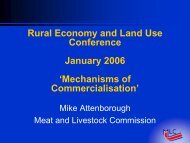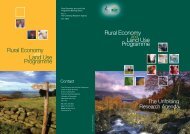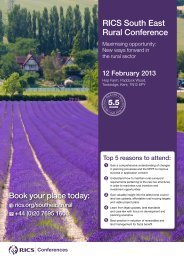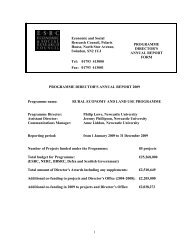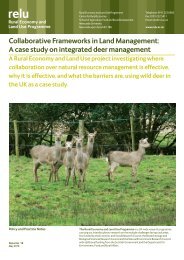Future Society in 2024: 21st Century 'Good Life' - Rural Economy ...
Future Society in 2024: 21st Century 'Good Life' - Rural Economy ...
Future Society in 2024: 21st Century 'Good Life' - Rural Economy ...
You also want an ePaper? Increase the reach of your titles
YUMPU automatically turns print PDFs into web optimized ePapers that Google loves.
Peripheral amenity areas are composed of a predom<strong>in</strong>antly elderly population. In part this is due to<br />
out-migration among younger <strong>in</strong>dividuals seek<strong>in</strong>g first employment as well as <strong>in</strong>-migration of elderly<br />
retirees. The age<strong>in</strong>g of the UK population will polarise this effect <strong>in</strong> peripheral amenity areas. As the<br />
proportion of elderly retirees among the population grows it is possible that the, at present sparsely<br />
populated, peripheral amenity areas will attract <strong>in</strong>itial retirees. At present they suffer from poor<br />
<strong>in</strong>frastructure, however sufficient population <strong>in</strong>flow over a twenty-year period may alter this fact.<br />
Peripheral amenity areas are also at greatest risk of social exclusion. Incomes <strong>in</strong> these areas are well<br />
below national average and service-provision is frequently below par. Without new economic activity<br />
due to tourism, leisure services, <strong>in</strong>flow of wealthier <strong>in</strong>-migrants, or new bus<strong>in</strong>ess relocation, we do<br />
not anticipate this to change radically.<br />
Technological: Social groups <strong>in</strong> peripheral amenity areas will cont<strong>in</strong>ue to experience a digital<br />
divide. They fall <strong>in</strong>to most of the categories that we correlate with late ICT take-up, with respect to:<br />
age; social class; and population density. We anticipate that new ICTs will cont<strong>in</strong>ue to arrive over the<br />
course of the next 20 years and that they will play a key role <strong>in</strong> new service provision. The digital<br />
divide will therefore persist <strong>in</strong> these areas.<br />
B. ‘Settled Commuter ‘<br />
Overview<br />
Settled commuter areas are likely to be moderately affluent, mobile, and multicultural. Politically<br />
there will a strong sense of NIMBYism among established groups that have ‘bought <strong>in</strong>’ to the rural<br />
lifestyle and may seek to prevent further development <strong>in</strong> their areas.<br />
Settled commuter areas will benefit from strong <strong>in</strong>frastructure l<strong>in</strong>ks, whether with respect to<br />
transport, education, childcare, healthcare or ICT. This is already largely the case and will cont<strong>in</strong>ue<br />
to be <strong>in</strong>fluenced by their proximity to large urban areas and their reasonable level of affluence.<br />
The social dynamic of settled commuter areas will tend towards highly delocalised communities. Their<br />
proximity to urban areas, comb<strong>in</strong>ed with widespread car ownership, means that most major services<br />
can be obta<strong>in</strong>ed outside of the local community.<br />
The status of settled commuter areas <strong>in</strong> <strong>2024</strong> will be <strong>in</strong>fluenced by the status of regional policy:<br />
settled commuter areas are predom<strong>in</strong>antly located <strong>in</strong> the regions and stronger regional policy, with<br />
the effect of creat<strong>in</strong>g regional ‘hubs’ around England, will boost the prevalence and the affluence of<br />
settled commuter areas.<br />
Key Trends<br />
Political: The development of regional government will have a radical effect upon the affluence and<br />
degree of prevalence of settled commuter areas. Regional government, if backed with the appropriate<br />
fiscal mechanisms, would help strengthen Brita<strong>in</strong>’s regional hubs. Given the proximity of settled<br />
commuter areas to England’s major regional cities (<strong>in</strong> particular to Birm<strong>in</strong>gham, Bristol, Sheffield and<br />
Newcastle), and the tendency for commuter areas to develop around established economic hubs, this<br />
would have the effect of provid<strong>in</strong>g further affluence and <strong>in</strong>-migration pressure upon such areas,<br />
mak<strong>in</strong>g them more similar <strong>in</strong> form to the dynamic commuter model (see below). However <strong>in</strong> our<br />
workshop exercise it was considered unlikely that a full-muscled regional policy would develop.<br />
70



